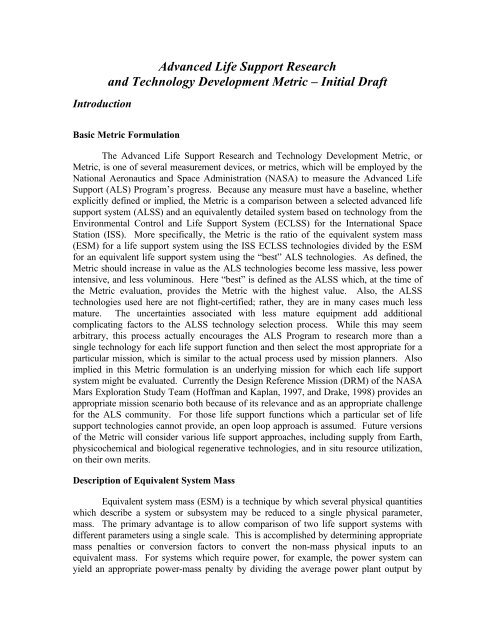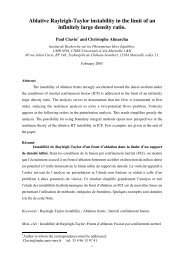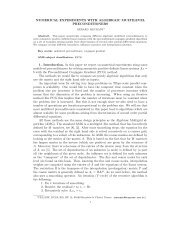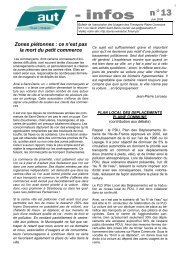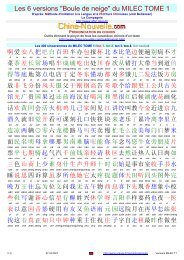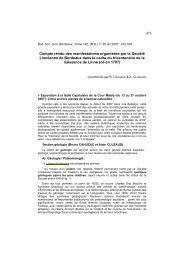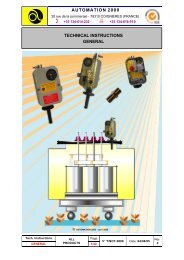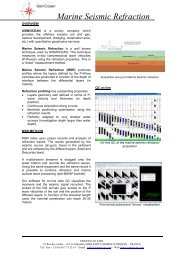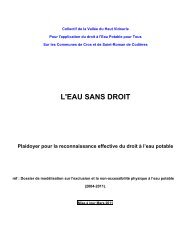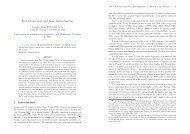Advanced Life Support Research and Technology Development Metric
Advanced Life Support Research and Technology Development Metric
Advanced Life Support Research and Technology Development Metric
You also want an ePaper? Increase the reach of your titles
YUMPU automatically turns print PDFs into web optimized ePapers that Google loves.
Introduction<strong>Advanced</strong> <strong>Life</strong> <strong>Support</strong> <strong>Research</strong><strong>and</strong> <strong>Technology</strong> <strong>Development</strong> <strong>Metric</strong> – Initial DraftBasic <strong>Metric</strong> FormulationThe <strong>Advanced</strong> <strong>Life</strong> <strong>Support</strong> <strong>Research</strong> <strong>and</strong> <strong>Technology</strong> <strong>Development</strong> <strong>Metric</strong>, or<strong>Metric</strong>, is one of several measurement devices, or metrics, which will be employed by theNational Aeronautics <strong>and</strong> Space Administration (NASA) to measure the <strong>Advanced</strong> <strong>Life</strong><strong>Support</strong> (ALS) Program’s progress. Because any measure must have a baseline, whetherexplicitly defined or implied, the <strong>Metric</strong> is a comparison between a selected advanced lifesupport system (ALSS) <strong>and</strong> an equivalently detailed system based on technology from theEnvironmental Control <strong>and</strong> <strong>Life</strong> <strong>Support</strong> System (ECLSS) for the International SpaceStation (ISS). More specifically, the <strong>Metric</strong> is the ratio of the equivalent system mass(ESM) for a life support system using the ISS ECLSS technologies divided by the ESMfor an equivalent life support system using the “best” ALS technologies. As defined, the<strong>Metric</strong> should increase in value as the ALS technologies become less massive, less powerintensive, <strong>and</strong> less voluminous. Here “best” is defined as the ALSS which, at the time ofthe <strong>Metric</strong> evaluation, provides the <strong>Metric</strong> with the highest value. Also, the ALSStechnologies used here are not flight-certified; rather, they are in many cases much lessmature. The uncertainties associated with less mature equipment add additionalcomplicating factors to the ALSS technology selection process. While this may seemarbitrary, this process actually encourages the ALS Program to research more than asingle technology for each life support function <strong>and</strong> then select the most appropriate for aparticular mission, which is similar to the actual process used by mission planners. Alsoimplied in this <strong>Metric</strong> formulation is an underlying mission for which each life supportsystem might be evaluated. Currently the Design Reference Mission (DRM) of the NASAMars Exploration Study Team (Hoffman <strong>and</strong> Kaplan, 1997, <strong>and</strong> Drake, 1998) provides anappropriate mission scenario both because of its relevance <strong>and</strong> as an appropriate challengefor the ALS community. For those life support functions which a particular set of lifesupport technologies cannot provide, an open loop approach is assumed. Future versionsof the <strong>Metric</strong> will consider various life support approaches, including supply from Earth,physicochemical <strong>and</strong> biological regenerative technologies, <strong>and</strong> in situ resource utilization,on their own merits.Description of Equivalent System MassEquivalent system mass (ESM) is a technique by which several physical quantitieswhich describe a system or subsystem may be reduced to a single physical parameter,mass. The primary advantage is to allow comparison of two life support systems withdifferent parameters using a single scale. This is accomplished by determining appropriatemass penalties or conversion factors to convert the non-mass physical inputs to anequivalent mass. For systems which require power, for example, the power system canyield an appropriate power-mass penalty by dividing the average power plant output by
the total mass of the generating power system. Thus, for a nuclear power system on anindependent l<strong>and</strong>er which, on average, delivers 100 kW of electrical power <strong>and</strong> has aoverall mass of 8,708 kg (Mason, et al., 1992) 1 the power mass penalty is 11.48 W/kg.This power-mass penalty effectively assigns a fraction of the power system mass to apower-using subsystem in place of that subsystem’s power requirement. In like manner,mass penalties to account for heat rejection <strong>and</strong> volume within a pressurized shell aredefined. Work is also in progress to define a crew-time-mass penalty to convertmaintenance time to mass, but the derivation for this conversion factor is not as obvious.A form developed by Drysdale (1998) is used in this work. The definition of equivalentmass for a system is the sum of the equipment mass plus the power, volume, thermalcontrol, <strong>and</strong> crew time as masses.BackgroundMars Reference BaselineAs per the DRM (Hoffman <strong>and</strong> Kaplan, 1997, <strong>and</strong> Drake, 1998), a vehicle with arigid shell, the Mars Transfer Vehicle (MTV), transports the crew from Earth orbit to thesurface of Mars. The MTV, once on the surface of Mars, is incorporated into the surfacehabitat. In addition to the MTV, the surface habitat includes an additional dedicatedl<strong>and</strong>er which provides some additional living volume for the crew during the mission’sexploration phase. The additional pressurized volume used solely on the surface employsan inflatable structure, as proposed for the TransHab 2 program, as per the DRM. Aseparate Earth Return Vehicle (ERV), which is initially deployed ahead of the crew,transports the mission personnel back to Earth. Thus, two long-duration life supportsystem hardware sets were assumed for each mission. The life support systems employedduring descent to Mars, ascent from Mars, which uses a separate vehicle in the currentDRM, <strong>and</strong> within the Earth-return capsule are omitted. Such systems, especially withinthe ascent vehicle <strong>and</strong> Earth-return capsule, are expected to operate for no longer than afew days <strong>and</strong>, therefore, are likely to use expendable, open-loop technologies. Alternateassumptions might be made, including use of a reusable transit vehicle, <strong>and</strong> a single shipsetfor the surface. However, the annual resupply mass (consumables) is about a third of thefixed mass, so this might not be economical. The DRM defines the overall mission as:1 The actual mass quoted here has been adjusted slightly to account for some differences between thework listed in the reference <strong>and</strong> the desired system.2 The TransHab is a concept to create an inflatable module with greater volume than a st<strong>and</strong>ardInternational Space Station (ISS) rigid module while using no more volume during launch than iscurrently available within the Space Transportation System (STS) Orbiter payload bay. Effectivelythe TransHab has a non-rigid outer structure which is inflated or deployed once the vehicle reachesorbit. Internal outfitting is accomplished by deploying folded structures <strong>and</strong>/or by movingappropriate equipment into the shell’s volume once it deployed. Drake (1998), page 43, provides apicture of a transfer vehicle with a TransHab crew compartment.
Number of Crew per Mission 6Transit Duration180 days (nominal)Surface Duration600 days (nominal)Number of Missions to One Site 3<strong>Metric</strong> Baseline AssumptionsFor both life support systems, a habitable volume of 50 m³ per person has beenincluded. This is primarily a pressure-vessel cost, <strong>and</strong> there is a difference between ISStechnology (0.015 m³/kg), <strong>and</strong> an inflatable structure such as TransHab, (0.43 m³/kg). AnISS pressure vessel is assumed for interplanetary transit while inflatable structures areassumed for the additional habitable volume provided on the surface. Makeup gas forleakage <strong>and</strong> the mass for filling the volume once have been included for ISS. For theadvanced life support system (ALSS) case, all gas masses are assumed to be included inthe mass of gas provided.Crew time is assumed to be 50 hrs of time devoted to mission goals per crewmember per week. Additional time will be required for base operations. Assuming themost significant mission work is done on the surface of Mars, crew time here is onlycounted for days spent on Mars. Thus, a crew of six will provide 76,932 hours over threemissions.No provision has been made for contingencies. Further, radiation shielding isomitted, as the requirement is ill-defined at present <strong>and</strong> the penalty is expected to besimilar in both cases. Finally, support for extravehicular activities (EVA) <strong>and</strong> theirassociated airlock operations have also been omitted. While EVA loads on a life supportsystem (LSS) are far from negligible, further study is necessary to define the actual EVAloads. Thus, while this is a useful estimate of technological capability, it does not directlyrepresent a good estimate for the LSS initial mass in low Earth orbit (IMLEO).Waste disposition is limited to overboard jettison for the ALSS scenario. ISSreturns waste to Earth, using either a soft l<strong>and</strong>ing on-board the Space TransportationSystem (STS, or Shuttle) or incineration during re-entry. However, this is believed to be arelatively small item, <strong>and</strong> is not addressed in these estimates.International Space Station Environmental Control <strong>and</strong> <strong>Life</strong> <strong>Support</strong> System<strong>Technology</strong> BaselineThe numerator of the <strong>Metric</strong> is an ESM estimate of a LSS for a mission to Marsbased on technology from the ISS ECLSS <strong>and</strong> the DRM.Background ISS ECLSS <strong>Technology</strong> InformationThe ISS ECLSS technology is defined in various documents (such as Carrasquillo,et al., 1997), often at a high level of detail The values here have been adjusted to removeany overcapacity as this is a form of contingency. EVA <strong>and</strong> airlock related items havealso been removed. Appropriate duration <strong>and</strong> infrastructure equivalencies have also beenapplied. The assessment presented is based on the ECLSS of the U. S. On-Orbit Segmentof the ISS (USOS).
Fixed masses, mostly equipment, <strong>and</strong> time dependent masses, mostly consumables,are identified separately <strong>and</strong> applied as appropriate to the mission. Note that the ISSbaseline for food is taken from Bourl<strong>and</strong> (1998), though Hanford (1997) provides asimilar value.ISS ECLSS Mission Definition DataNumber of Crew 4 USOS onlyNominal Duration 3,650 days at the same site, or 10 Earth years.LocationLEOISS ECLSS Infrastructure CostsFactor Value Units CommentsMass Delivery Factor 2 kg packaged/kg unpackagedFor components requiring packaging(food <strong>and</strong> clothing)Pressurized Volume 0.015 m³/kg ISS common module;No shielding or secondary structuresPower 11.4 W/kg Nuclear power; Based on SP100 ProgramHeat Rejection 25.4 W/kgCrew Time 2 person•hr/kg A rough estimateDerived Costs for MissionEnergy 492.48 kWh/kgHeat Rejection 3,950.2 kWh/kgReferences: Hanford (1997) <strong>and</strong> Hanford <strong>and</strong> Ewert (1996).ISS Food <strong>and</strong> Clothing Componentskg/(person•day)Required Food (hydrated) 1.955Total Food Mass 3.910Clothing 1.4Packaged Clothing 2.8From Bourl<strong>and</strong> (1998) <strong>and</strong> ISS Laundry Package. The dry weight value for ISS food is0.674 kg/(person•day) excluding packaging. The full mass of food includes moisture asISS food is not completely dehydrated.ISS ECLSS Physical Quantities Translated to Equivalent System Mass (ESM)EquipmentMass[kg ESM]ResupplyMass[kg ESM]AssumedVolume[kg ESM]ResupplyVolume[kg ESM]AveragePower[kW]AverageCooling[kW]CrewTime[kg ESM]TotalMass[kg ESM]2,031 119,808 18,059 6,641 621 269 457 147,8861.4% 81.0% 12.2% 4.5% 0.4% 0.2% 0.3%Physical mass (equipment/initial mass plus the resupply mass) equals 121,838 kg ESM <strong>and</strong>accounts for 82.4% of the total equivalent system mass.
International Space Station Environmental Control <strong>and</strong> <strong>Life</strong> <strong>Support</strong> System (excluding equipment for Extravehicular Activities <strong>and</strong> Airlock operations)Average Assumed Resupply Average Average System PercentageSystem / ItemMass[kg]Volume[m³]Power[kW]USOSNumMass[kg]Volume[m³]Mass[kg]Volume[m³]Power[kW]Cooling[kW]Crew Time[per•hr/yr]ESM[kg ESM]ESM[kg ESM]of TotalECLSSAir Revitalization System (ARS) 2,901.3 2.0%Carbon Dioxide Removal Assembly (CDRA) 201.0 0.39 0.860 1 201.0 0.86 0.86 2.7 323.8Trace Contaminant Control Subsystem (TCCS) 78.2 0.175 1 78.2 163.0 0.340 0.18 0.18 4.4 1,979.0Major Constituent Analyzer (MCA) 54.7 0.44 0.088 1 54.7 12.0 0.023 0.09 0.09 0.4 203.5Oxygen Generation Assembly (OGA) 113.0 0.14 1.470 0.57 64.6 12.7 0.010 1.47 1.47 2.0 395.1Temperature <strong>and</strong> Humidity Control System (THCS) 1,488.9 1.0%Common Cabin Air Assembly (CCAA) 112.0 0.40 0.468 3 336.0 1.200 1.66 1.66 627.0Avionics Air Assembly (AAA) 12.4 0.03 0.083 3 37.2 0.102 0.25 0.25 75.8Intermodule Ventilation (IMV) Fan 4.8 0.01 0.055 5 24.0 0.045 0.22 0.22 55.0Intermodule Ventilation (IMV) Valve 5.1 0.01 0.006 15 76.5 0.149 0.01 0.01 87.2High Efficiency Particle Atmosphere (HEPA) Filter 2.0 0.01 15 30.0 0.120 47.0 0.189 2.0 644.0Fire Detection <strong>and</strong> Suppression 75.1 0.1%Smoke Detector 1.5 0.002 8 12.0 12.0Portable Fire Extinguisher (PFE) 15.1 0.04 4 60.4 0.041 63.1Crew Cabin 15,101.4 10.2%Volume: 50 m³/person 200.00 200.000 13,333.3Air: 1 volume of gas 258.9 258.9 258.9Leakage Rate: 83 kg/(module•yr)150.9 1,509.1Vacuum System The largest item is 10 kg - negligible 0.0Water Recovery <strong>and</strong> Management (WRM) <strong>and</strong> Waste Management (WM) 22,674.3 15.3%Water Processor (WP) 476.0 10.39 0.300 1 476.0 478.0 0.30 0.30 6.0 5,324.1Process Control Water Quality Monitor (PCWQM) 38.0 0.51 0.030 1 38.0 0.03 0.03 1.0 46.8Urine Processor (UP) 128.0 0.37 0.091 1 128.0 175.0 2.178 0.09 0.09 13.0 3,406.6Fuel Cell Water Storage 21.0 0.10 4 84.0 684.0 6,924.0Condensate Storage 21.0 0.10 1 21.0 21.0Commode / Urinal 50.0 0.072 1 50.0 435.0 3.364 0.07 0.07 60.0 6,951.8Other Miscellaneous 105,645.1 71.4%Food 5,708.6 1.61 1.61 57,290.7Clothing 4,114.5 3.857 43,717.0Miscellaneous Power 0.25 22.0ECLSS Racks (10) 69.230 4,615.3Total ISS ECLSS 1,593 212.9 2,031 270.89 11,981 9.96 7.1 6.8 91 147,886
Breakdown of ISS ECLSS Equivalent System Mass Components by SystemSystemAssumedMass[kg]ResupplyMass[kg/yr]AssumedVolume[m³]ResupplyVolume[m³/yr]AveragePower[kW]AverageCooling[kW]Crew Time[per•hr/yr]Percentageof TotalECLSSESM[kg ESM]Air 1,233.5 385.6 201.657 0.562 4.73 4.73 11.5 19,567 13.2%Clothing 0 4,114.5 0 3.857 0 0 0 43,717 29.6%Food 0 5,708.6 0 0 1.61 1.61 0 57,291 38.7%Waste 0%Water 797.0 1,772.0 0 5.542 0.49 0.49 80.0 22,674 15.3%Other 0 0 69.230 0 0.25 0 0 4,637 3.1%<strong>Advanced</strong> <strong>Life</strong> <strong>Support</strong> System <strong>Technology</strong> BaselineThe ALSS technology baseline is an example of an ALS Program LSS fromJohnson Space Center (Lin, 1997), with additional components added for completeness<strong>and</strong> comparability to the ISS case. The selections presented in this particular baselinearose from a preliminary study of a life support configuration for a transit vehicle for amission to Mars using a TransHab-style inflatable structure for the crew module. Theunderlying reference mission, which differs from the DRM <strong>and</strong> the reference mission forthe <strong>Metric</strong>, assumed a single vehicle would transport the crew from Earth orbit to Mars<strong>and</strong> then back to Earth again. Separate vehicles would transfer the crew to the surface ofMars <strong>and</strong> provide a habitat once there. As such, the technology selection process did notconsider surface operations. While systems designed to function in microgravity generallyare not gravity sensitive <strong>and</strong> will function on a planetary surface, overall such anequipment selection may not be optimal. Finally, because the systems included are underdevelopment <strong>and</strong> not flight-ready, the physical attributes are less precise than the valuesfor the USOS equipment. Thus, the ALSS baseline should be considered representative,but not necessarily optimal, for the reference mission.Thus, the ALSS case is extrapolated from ALS Program values developed atJohnson Space Center. The original ALSS values (Lin, 1997) have been updated withmore recent values (Hanford, 1998) where possible. The ALSS here is primarily aphysicochemical system with a biological primary water processor <strong>and</strong> very limitedbiological food production. The system is defined in detail in the tables below. Itrepresents an advance over ISS technology, <strong>and</strong> is for a 400-day outbound <strong>and</strong> returntransit. As noted above, similar technology should work on the surface, <strong>and</strong> should beindependent of the mission scenario. This scenario does include a small plant growthchamber. The mass allocated is 120 kg. This is adequate for about a half square metergrowing area. Half a square meter could produce as much as 1% of the food for the crewwith a high productivity cereal crop, or as low as 0.1% for a low productivity crop.Food, clothes, <strong>and</strong> laundry are not covered by these references, <strong>and</strong> have beenadded. These masses are large compared to other equipment. Nevertheless, these itemswill be important issues when comparisons to bioregenerative options are eventuallyundertaken. Radiation protection could also be an issue when considering transit vehicles,but it can be ignored as a first approximation.Food cost is taken from Hanford (1997). This value is 12% lighter than the figureused for ISS technology case. This is reasonable assuming a greater use of dehydratedfood for longer-duration trips <strong>and</strong> the availability of a small quantity of fresh food.
For clothing, a laundry is assumed. This would be a non-critical item, but it mayprovide significant savings (ISS Laundry package).ALSS Sizing AssumptionsPhysical Quantity Value UnitsCrew Size 6 peopleMission Duration 400 daysCabin AtmosphereTotal Cabin Pressure 59.2 kPaPartial Pressure – Oxygen 17.8 kPaPartial Pressure – Carbon Dioxide 0.4 kPaLeakage Rate 0.76 kPaHuman ConsumptionFood 11.8 MJ/(person•day)Oxygen Consumption 0.835 kg/(person•day)Carbon Dioxide Production 0.998 kg/(person•day)Water UsageWater Consumption (Food & Drink) 3.52 kg/(person•day)Hygiene Water Usage 4.44 kg/(person•day)Shower Water Usage 2.72 kg/(person•day)Urinal Flush Usage 0.49 kg/(person•day)Dish Wash Usage 5.44 kg/(person•day)Clothing Wash Usage 12.47 kg/(person•day)Total Water Consumption / Usage 29.08 kg/(person•day)ALSS Infrastructure CostsFactor Value Units CommentsMass Delivery Factor 2 kg packaged/kg unpackagedFor components requiring packaging(food <strong>and</strong> clothing)Pressurized Volume 0.062 m³/kg TransHab inflatable module including 19cm of water for “storm shelter” shieldingPower 12.0 W/kg Solar power.Heat Rejection 25.4 W/kgFood 1.725 kg/(per•day)Clothes 0.267 kg/(per•day) Clothes are washed in a laundry.Spares & Expendables 15% An estimate in the absence of better data.References: Hanford <strong>and</strong> Ewert (1996), <strong>and</strong> ISS Laundry Package.ALSS Equivalent System Mass Calculations [kg ESM]Mass Resupply Volume Power Cooling TotalEquivalent System Mass 12,739 272 5,269 598 283 19,161Percentage of Total ESM 66.5% 1.4% 27.5% 3.1% 1.5%Breakdown of Equivalent System Mass ComponentsMass Resupply Volume Power Cooling TotalFixed Costs [kg] 3,062.0 5,115.1 598.2 282.6 9,057.9Time Dependent Costs [kg/mission] 9,677.4 271.8 154.2 10,103.4Time Dependent Costs [kg/day] 24.2 0.7 0.4 25.3
An <strong>Advanced</strong> <strong>Life</strong> <strong>Support</strong> System (based on physicochemical technologies <strong>and</strong> estimates for TransHab)Air Revitalization System <strong>Technology</strong> Assumed [Program] / Notes Mass [kg] Resupply [kg] Volume [m³] Power [kW] Cooling [kW]Air Pressure ARPCS [X-38] 74.0 11.1 0.41 0.100 0.100Oxygen/Nitrogen Storage high pressure [Space Transportation System (STS)] 284.0 0 1.21 0.008 0.008Humidity Control anti-microbial condensing heat exchanger [LMLSTP Ph IIA] 46.0 6.9 0.26 0.400 0.400Air Temperature Control anti-microbial condensing heat exchanger [LMLSTP Ph IIA] 99.0 14.9 0.74 0.370 0.370Carbon Dioxide Removal [Node 3] 176.0 13.8 0.45 0.365 0.365Carbon Dioxide Reduction (a) Sabatier 31.0 4.2 0.44 0.130 0.130Oxygen Production (a) Solid Polymer Water Electrolysis (SPWE) 120.9 18.0 1.12 1.840 1.840CO 2 Reduction/O 2 Production (b) Salad Machine / This item is carried in food production.Trace Contaminant Control [Node 3] 77.0 5.6 0.14 0.128 0.128Particulate <strong>and</strong> Microbe Control reusable filters 7.0 1.1 0.08 0 0Air Pressure Monitoring sensors [International Space Station (ISS)] 2.0 0.3 0 0.005 0.005Air Composition Monitoring [Space Transportation System (STS)] 6.0 0.9 0 0.015 0.015Fire Detection <strong>and</strong> Suppression smoke detector <strong>and</strong> halon 19.0 2.9 0.05 0.050 0.050Crew Cabin Volume [TransHab] / The mass of gas is assumed to be elsewhere. 300.00Water Recovery System <strong>Technology</strong> Assumed [Program] / Notes Mass [kg] Resupply [kg] Volume [m³] Power [kW] Cooling [kW]Urine Pretreatmentflush + solid agent / This item is included in water storage.Urine Processing Bioreactor + Reverse Osmosis + Air Evaporative Subsystem 175.0 87.0 0.60 1.450 1.450Hygiene Waste Storage Bladder-less tanks 203.0 0.64Hygiene Waste Processing Bioreactor + Reverse Osmosis + Air Evaporative Subsystem 76.0 6.9 0.99 0.200 0.200Hygiene Waste Post Processing Milli-Q + ammonia removal 56.0 8.0 0.55 0.540 0.540Microbial Control iodine microbial check valve 10.0 1.5 0.012 0.012Water Quality Monitoring Water Quality Monitoring (WQM) [ISS] 39.0 5.9 0.08 0.100 0.100Potable Water Storage bladder-less tanks 950.0 1.61 0.020 0.020Waste H<strong>and</strong>ling & Processing <strong>Technology</strong> Assumed [Program] / Notes Mass [kg] Resupply [kg] Volume [m³] Power [kW] Cooling [kW]Urine CollectionWaste Management Subsystem [ISS] / This item is included with feces collection.Urine Storage bladder-less tanks 49.0 0.32Feces Collection <strong>and</strong> Storage Waste Management Subsystem [ISS] 103.0 15.5 1.28 0.340 0.340Other Solid Wastes trash compactor [International Space Station (ISS)] 27.0 4.1 0.09 0.060 0.060Solid Waste Processing stabilization + disposal <strong>and</strong> incineration 225.0 33.8 2.38 0.265 0.265Solid Waste Disposal overboard jettison [International Space Station (ISS)] 59.0 8.9 1.77 0.130 0.130Miscellaneous <strong>Technology</strong> Assumed [Program] / Notes Mass [kg] Resupply [kg] Volume [m³] Power [kW] Cooling [kW]Food Supplystorage [ISS] <strong>and</strong> on-board production / This item is included in Crew Accommodations; 100% food provided.Regenerative Food Production Salad Machine / Less than 10% production. 120.0 18.0 1.94 0.650 0.650System Monitoring <strong>and</strong> Control intelligent monitoring <strong>and</strong> control (M&C) 20.0 3.0System Operations Planning artificial intelligence (AI) expert system / Included in M&CCrew Accommodation System <strong>Technology</strong> Assumed [Program] / Notes Mass [kg] Resupply [kg] Volume [m³] Power [kW] Cooling [kW]Food 1.725 kg/(person•day) 8,280.0 8.28Clothes 0.267 kg/(person•day) 1,279.2 1.28Laundry 118.2Totals 12,739.4 271.8 326.70 7.178 7.178
<strong>Advanced</strong> <strong>Life</strong> <strong>Support</strong> <strong>Research</strong> <strong>and</strong> <strong>Technology</strong> <strong>Development</strong> <strong>Metric</strong>For the <strong>Metric</strong>, the following infrastructure costs are assumed:Infrastructure Costs Transit Surface UnitsPressurized Volume 0.015 0.48 m³/kgPower 12 18 W/kgHeat Rejection 47.5 15 W/kgThe infrastructure costs here represent the incremental costs for pressurized volume,power, <strong>and</strong> heat rejection. Additionally, a crew time cost is presented based on each case.For the transit mission segment, the MTV <strong>and</strong> ERV use modules with rigid shells. Poweris provided by converting solar energy to electricity using photovoltaic cells. On thesurface, any additional volume above <strong>and</strong> beyond what is provided by the MTV isprovided by an inflatable structure. Power is provided by Brayton conversion from anuclear power plant of the SP100 class sized to generate 100 kW continuously. In bothcases, lightweight, inflatable systems are used for heat rejection. The differences in heatrejection costs reflect differences in the thermal environment on the surface of Marscompared to that of interplanetary space.Equivalent System Mass for ISS ECLSS <strong>Technology</strong> BaselineIn the tables which follow, the ISS ECLSS technology LSS have been resized for acrew of six versus the four crew in the baseline for the LSS of the USOS. Appropriateduration <strong>and</strong> infrastructure equivalencies have also been applied.ISS ECLSS BaselineCrew 4 peopleDuration 3,650 daysMass[kg]Volume[m³]Power[kW]Cooling[kW]Fixed Values 2,031 271 7.08 6.83Time DependentValuesCrew Time[per•hr/kg]ResupplyMass[kg/yr]ResupplyVolume[m³/yr]91 9,922 9.96ISS ECLSS Baseline modified for Mars Design Reference MissionCrew 6 peopleDuration 2340 daysMass[kg]Volume[m³]Power[kW]Cooling[kW]Fixed Values 3,046.5 406.5 10.6 10.2Time DependentValuesCrew Time[per•hr/kg]ResupplyMass[kg/yr]ResupplyVolume[m³/yr]136.5 14,883.0 14.9
Once the total physical requirements of the LSS using the ISS ECLSS technologyare determined, an overall ESM may be determined by applying the infrastructure costs.Note that the crew time cost is determined iteratively in this computation because itdepends on the ESM of the LSS for the remaining cost factors.ALS <strong>Metric</strong> Equivalent System Mass Calculations for ISS ECLSS <strong>Technology</strong> [kg ESM]Mars Transfer Vehicle Mass Volume Power Cooling Crew Time Total ESM(MTV)Transit Out 10,386 27,591 885 216 277 39,355Surface Operations 24,465 51 590 683 922 26,712MTV Total 66,066Earth Return Vehicle (ERV) Mass Volume Power Cooling Crew Time Total ESMTransit Back 10,386 27,591 885 216 277 39,355Single Mission Totals 45,237 55,234 2,360 1,114 1,476 105,421Three Mission Totals 135,712 165,701 7,080 3,343 4,427 316,262The total for all three missions is 316 metric tons. Dividing the crew mission time by theESM yields a crew time equivalency of 0.243 person•hr/kg. This marginal cost is used forestimating LSS crew time costs, though the impact in this case is negligible.Equivalent System Mass for ALSS <strong>Technology</strong> BaselineIn the tables which follow, the ALSS technology, detailed earlier, has been resizedusing appropriate duration <strong>and</strong> infrastructure equivalencies.ALS BaselineCrew 6 peopleDuration 400 daysMass[kg]Volume[m³]Power[kW]Cooling[kW]Fixed Values 3,062 317 7.18 7.18Time DependentValuesCrew Time[per•hr/kg]ResupplyMass[kg/yr]ResupplyVolume[m³/yr]136.5 10,103 9.6ALS <strong>Metric</strong> Equivalent System Mass (ESM) Calculations for ALSS <strong>Technology</strong> [kg ESM]Mars Transfer Vehicle Mass Volume Power Cooling Crew Time Total ESM(MTV)Transit Out 7,609 21,429 598 151 183 29,971Surface Operations 15,155 30 399 479 612 16,674MTV Total 46,645Earth Return Vehicle (ERV) Mass Volume Power Cooling Crew Time Total ESMTransit Back 7,609 21,429 598 151 183 29,971Single Mission Totals 30,372 42,889 1,595 781 979 76,615Three Mission Totals 91,116 128,666 4,785 2,342 2,936 229,846The total cost for all three missions would be 230 metric tons. Using the same approachfor crew time as above, the crew time equivalency is 0.335 person•hr/kg.
The ALSS technologies yield significantly less massive system than do the ISSECLSS technologies. The <strong>Metric</strong> is defined as the ratio of the ESM for a LSS using ISSECLSS technologies divided by the ESM for a LSS using ALSS technologies. OrThe <strong>Metric</strong> =ESM of LSS using ISS ECLSS technologiesESM of LSS using ALSS technologies316,262 kgThe <strong>Metric</strong> == 1.38229,846 kgThus, the ALSS technologies are 27% less massive than the corresponding ISS ECLSStechnologies <strong>and</strong> yield a <strong>Metric</strong> value of 1.38 based on current estimates.Cautions <strong>and</strong> DisclaimersThese system level equivalent mass estimates are preliminary, <strong>and</strong> somewhatheterogeneous. The level of detail is about comparable, but the data are not classifiedexactly the same. In the interests of time, simplifications have been made. However, theapproach is clearly defined, <strong>and</strong> presents an approach that can be refined.As stated above, these estimates intentionally do not include contingency. A valid<strong>and</strong> acceptable contingency plan will be needed that can be applied to both approaches inorder to adequately identify the real mission masses.ReferencesBourl<strong>and</strong>, C. T. (1998) Flight Crew <strong>Support</strong> Division, National Aeronautics <strong>and</strong>Space Administration, Lyndon B. Johnson Space Center, Houston, Texas.Personal communication.Carrasquillo, R. L., Reuter, J. L., <strong>and</strong> Philistine, C. L. (1997) “Summary ofResources for the International Space Station Environmental Control <strong>and</strong> <strong>Life</strong><strong>Support</strong> System,” SAE 972332, 27 th International Conference on EnvironmentalSystems, Lake Tahoe, Nevada, July 14-17, 1997, Society of AutomotiveEngineers, Inc., Warrendale, Pennsylvania.Drake, B. G. (1998) “Reference Mission Version 3.0, Addendum to the HumanExploration of Mars: The Reference Mission of the NASA Mars ExplorationStudy Team,” EX13-98-036, Exploration Office, National Aeronautics <strong>and</strong> SpaceAdministration, Lyndon B. Johnson Space Center, Houston, Texas, June, 1998.This document may be found on the Internet at:http://exploration.jsc.nasa.gov/explore/explore.htmDrysdale, A. E. (1998) The Boeing Company, Kennedy Space Center, Florida.Personal communication.Hanford, A. J. (1997) “<strong>Advanced</strong> Regenerative <strong>Life</strong> <strong>Support</strong> System Study,”JSC-38672, National Aeronautics <strong>and</strong> Space Administration, Lyndon B. JohnsonSpace Center, Houston, Texas.
Hanford, A. J. (1998) Lockheed Martin, Houston, Texas. Workshop presentation,March 1998 (Unpublished work).Hanford, A. J., <strong>and</strong> Ewert, M. K. (1996) “<strong>Advanced</strong> Active Thermal ControlSystems Architecture Study,” NASA-TM-104822, National Aeronautics <strong>and</strong>Space Administration, Lyndon B. Johnson Space Center, Houston, Texas.Hoffman, S. J., <strong>and</strong> Kaplan, D. L. (1997) “Human Exploration of Mars: TheReference Mission of the NASA Mars Exploration Study Team,” ExplorationOffice, National Aeronautics <strong>and</strong> Space Administration, Lyndon B. Johnson SpaceCenter, Houston, Texas, July, 1997. This is version 1.0. This document may befound on the Internet at:http://exploration.jsc.nasa.gov/explore/explore.htmISS Laundry Package (199x) Unpublished work.Lin, C. H. (1997) Crew <strong>and</strong> Thermal Systems Division, National Aeronautics <strong>and</strong>Space Administration, Lyndon B. Johnson Space Center, Houston, Texas.Personal communication.Mason, L. S., Rodriguez, C. D., McKissock, B. I., Hanlon, J. C., <strong>and</strong>Mansfield, B. C. (1992) "SP-100 Reactor with Brayton Conversion for LunarSurface Applications," NASA-TM-105637, National Aeronautics <strong>and</strong> SpaceAdministration, Lewis <strong>Research</strong> Center, Clevel<strong>and</strong>, Ohio.


